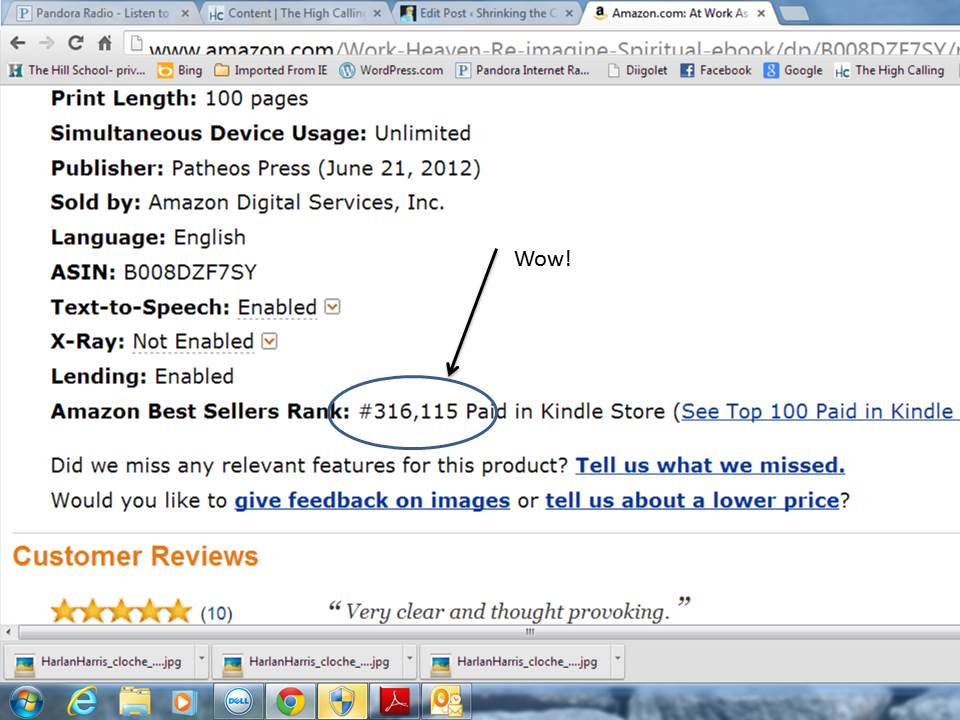Last week I had the privilege of publishing a guest post on Michael Hyatt’s blog, Leading with Purpose.
This was a pretty big deal to me, seeing as Mr. Hyatt is the CEO of Thomas Nelson Publishing, the largest Christian publisher in the world and the seventh-largest book publisher in the U.S. All of which is to say that this man gets hounded by thousands of desperately frustrated unpublished authors, which makes for a conveniently captive blog audience.
Writing a guest post was great exposure, for sure, and many nice people stopped by to congratulate me when they heard the news. But here it is a couple weeks later, and sadly, everything’s all back to normal again.
Some of you may wonder, then, what did such sweeping exposure actually do for my blogging career? (Not that my blog is a career, mind you. It’s more like a writing hobby that has gotten terribly out of control.) Did I get a book deal? Did Michael Hyatt fly me in to his office for coffee and leadership advice? Did the post get picked up by other literary agents and magazine editors, hungry for fresh, new talent?
I will tell you every excruciating detail. Here is the breakdown of what I learned from guest posting on Michael Hyatt’s blog.
1. It wasn’t’ hard to become a guest blogger.
If you spend any time reading his blog, you will quickly see that Mr. Hyatt is mostly into giving pithy advice on motivational leadership and social media topics. All of his posts use the typical Blogger 101 approach to writing standards: use scannable chunks of sentences; create easy-to-read lists and bullet points; have a strong opening paragraph; and offer plenty of links to other relevant sites. In fact, he pretty much tells you exactly what to do here, and gives more details in his guidelines for guest posts. It seems that as long as you are a decent writer with a unique story idea that fits his criteria, you’re in. Honestly, I don’t think his standards for accepting guest posts are really that stringent. Case in point: did you catch the piano teacher’s guest post on Friday? Really, you can do this too.
2. Don’t Be Deluded Into Thinking It Will Launch Your Writing Career.
Sure, the exposure and all that attention was fun – it was like being as famous as Michael Hyatt for a day. But it’s not like I suddenly started getting calls from literary agents and editors from The New Yorker telling me how brilliant I was. There was a flurry of excitement for a couple days with the comments, Tweets and new page views, and then nothing.
Although Michael did mention in an email that he “loved” my piece. That was nice.
3. There was about a 10% click-through back to my own site.
Over the course of the weekend that featured my guest post, I received about 350 new page views that came directly from the guest post on Hyatt’s blog. This is pretty good, but I honestly expected more.
How many page views do you think Michael Hyatt’s blog gets per day? He once mentioned that for every 100 page views, he gets one comment. By Sunday evening, the post had racked up 35 comments, so that would tell me he had 3,500 page views over the course of the three days. Again, I’m just guestimating here, but these calculations would say that approximately 10% of his readers came over and checked out my site.
4. It’s a quick way to score some new Twitter followers.
I got about 50 new Twitter followers during the three days while the guest post was up. Perhaps they were the same folks who came over to view my site to actually read what I was all about. But then again, with my byline at the top of the guest post, it was easy for a reader to simply click on the Twitter link and go. There is no commitment of more reading time required, which is what’s so great about Twitter. Either way, I’ll take it.
5. It generated mentions on 5 other blogs.
This was a pleasant surprise, to get recycled on to other people’s blog posts. Five other blogs mentioned my blog site with a direct link. Interestingly, only one of them was referring to the original guest post subject of Micro-Sabbaticals. The other four referred back to another link of mine that I had secretly embedded into the post content. More on this later.
None of these blog links have brought substantial traffic to my site
6. Four new subscribers signed up for email alerts.
Email subscriptions are nice, because you know these are people who actually buy into your blog and want to know when you have a new post. Four new subscribers signed up as a result of this guest post. Although this is a small number, it’s says that the guest post can definitely add incremental fans to your own site. And that’s how we build our blogs – one new reader at a time. Although it would be much nicer to build our blogs at 100 new readers at a time. Oh well. Also, I am hoping that there are others who have added my site to their Google Reader and will visit my blog again.
7. Build in a back-door link to your blog.
One of the smartest (and sneakiest) things I did in this guest post was to link back to another article on my blog site. In the guest post, I had suggested one idea for a micro-sabbatical was to take up meditation. Instead of linking to some already-famous and well-trodden instructional site, I linked back to an article I had written myself many months ago on the subject of Christian meditation. This worked like a charm, and was one of the big surprises that came out of this guest post. It drew 113 views of the 350 new page views, generated a couple great new comments and got picked up by four other blog posts. As if the readers were more interested in meditation than in micro-sabbaticals. Go figure.
8. Beware of the Michael Hyatt effect.
The top of the guest post clearly states that it is written by a guest, someone other than Mr. Hyatt, and provides a nice author byline containing links back to the guest’s blog site and twitter account. However, several clueless commentors still attributed the post to Michael, not me. “Great post, Michael!” “You did it again!” I call this “The Michael Hyatt Effect,” and found it extremely annoying. By the time these star-struck readers finished the article, they had forgotten who wrote it, and obviously didn’t care. As long as it was posted on Michael Hyatt’s blog, he got all the credit. Maybe I should just call it “The Suck-Up Effect.”
9. The traffic bump doesn’t last very long.
Although it was nice to get that jolt in traffic for a few days, things calmed down and went right back to normal again by Tuesday. No more famous-for-a-day. No more nice email messages from Michael Hyatt. No more mentions on other people’s blogs. The attention is fleeting, and then everyone just moves on and gets back to work.
I guess that’s a good lesson for all of us aspiring writers to remember.
Photo by nAncY, used with permission.












